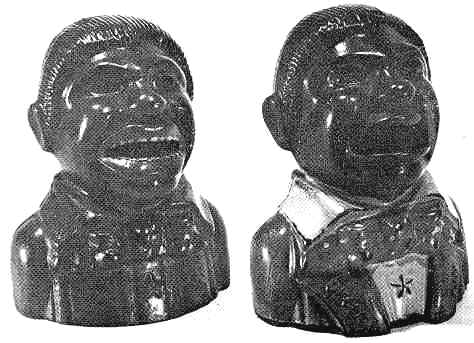Uncle Tom
by F.H. Griffith - HOBBIES Magazine - February, 1966

There are two Uncle Tom mechanical banks, one with the name thereon, the other without; each, however, has the initials U.T. on the coin trap. They are different banks even though they both have the same patent date and are somewhat alike in appearance. One is known as Uncle Tom (No Lapels) and this is our choice as No. 139 in the numerical classification. The other with the name on the lapels is called, of course, Uncle Tom and is No. 140 in the classification.
Both Uncle Tom banks were made by Kyser & Rex of Philadelphia, Pa. A patent was issued January 24, 1882 to Louis Kyser and Alfred C. Rex as an improvement in toy money boxes and it covered a bust type bank with certain moving parts. These parts, however, were not necessarily to be in accord with the diagram included with the patent papers. Thus we have two similar appearing banks which operate quite differently. Uncle Tom (No Lapels) is shown in Figure 1, and note that his lips and teeth are well defined and he has no jacket with lapels. His shirt is red and he has a blue tie with yellow polka dots. His tongue, lips, nostrils and corners of the eye sockets are red. His eyes are brown with black pupils and his teeth are white.
To operate this bank a coin is first placed on the tongue inside the mouth of the figure. A lever in back of the head is then pressed down. This causes the tongue to recede dropping the coin inside the bust. At the same time his eyes lower. On releasing the lever the moving parts return to the positions as shown in Figure 1.
Uncle Tom, Figure 2, has lips that protrude, no teeth, and wears a jacket with the name Uncle on the right lapel and Tom on the left. His jacket is blue with the name in gold. He has a white shirt and a red tie with white polka dots. His inside lower lip, tongue and eye socket corners are red. His eyes are white outlined in black with black pupils.
To operate this bank a lever located in the center of his back is first pressed or pushed in. This causes his tongue to come forward and protrude over his lower lip. At the same time his eyes roll up. A coin is then placed on his tongue and the lever released. The parts return to the position as shown in Figure 2 and the coin slides from his tongue on inside the bank. This bank operates on the basic principle as outlined in the drawing accompanying the patent papers. There is a spring shown in the patent drawing, but this is not necessary as the weight of the parts is sufficient to cause them to operate as described.
It is interesting to note that Uncle Tom, Figure 2, is one of the lever operated mechanical banks where the lever is pressed before the coin is placed in position. There are only a few mechanical banks that operate in this fashion, and one other that comes to mind at the moment is the Old Woman In The Shoe (HOBBIES, March, 1953).
Just why Kyser & Rex chose to make Uncle Tom in two different types may never be known for sure. Nor can we tell which was made first or if they were manufactured concurrently. Both mechanisms are sturdy and substantial and would stand considerable usage so this could not have been a factor. There is this possibility—when placing the coin on the tongue of the one in Figure 2 there is a tendency for the coin to slide off the tongue into the bank before the lever is released. Actually, while the writer’s preference seems to lean towards this bank, the other, Figure 1, operates much better and the coin cannot go into the bank until the lever is pressed.
In closing it bears mention that the rare Hindu Bank (HOBBIES, February, 1955) was produced by Kyser & Rex under the same patent as that covering both Uncle Tom banks. Detailed information concerning this was included in the Hindu Bank article.
